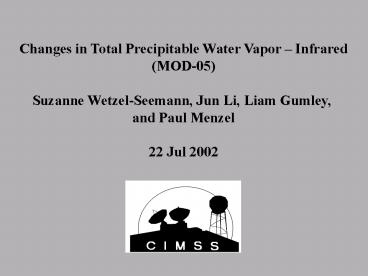Changes in Total Precipitable Water Vapor - PowerPoint PPT Presentation
Title:
Changes in Total Precipitable Water Vapor
Description:
... 36 from 60 clear sky cases at the SGP ARM-CART site from April 2001 to June 2002. ... north mid-latitude land agree fairly well with the CART site biases. ... – PowerPoint PPT presentation
Number of Views:34
Avg rating:3.0/5.0
Title: Changes in Total Precipitable Water Vapor
1
Changes in Total Precipitable Water Vapor
Infrared(MOD-05) Suzanne Wetzel-Seemann, Jun
Li, Liam Gumley, and Paul Menzel 22 Jul 2002
2
Earth emitted spectra overlaid on Planck function
envelopes
CO2
H20
O3
CO2
3
Total Water Vapor Retrieval from MODIS IR
Radiances
ps I? ??sfc B?(T(ps)) ??(ps) - ?
B?(T(p)) d??(p) / dp dp .
o I1, I2, I3, .... ,
In are measured with MODIS P(sfc) and T(sfc)
come from ground based conventional
observations ??(p) are calculated with physics
models Regression relationship is inferred
from (1) global set of in situ radiosonde
reports, (2) calculation of expected radiances,
and (3) statistical non-linear regression of
observed Raob TPW and calculated MODIS
radiances (brightness temperatures) Need
RT model, estimate of ??sfc, and MODIS radiances
4
Mitigating Problems in MODIS TPW
Algorithm
Changed predictors band 24 and 25 (4.4 and 4.5
um) brightness temperatures to their BT
difference to remove surface effects
Old algorithm had 12 predictors
individual bands 24, 25, and 27 through 36.
New algorithm has 11 predictors band 25 -
24 BT difference and individual bands 27
through 36. Separated training into seven
regression BT zones to include a broader range of
moisture regimes Implemented global radiance
bias corrections. Applied post-launch NEdT in
place of pre-launch.
December 18, 2001
MODIS Science Team Meeting
5
Previous MOD07 v3.0 (left) and new MOD07 v3.1.0
(right) for the north African deserts on June 2,
2001 at 0830-1155 UTC
6
MODIS new TPW 20 Aug 2001 18
UTC GOES -8
MODIS wo BT11 partitioning
7
Average (Observed-Calculated) brightness
temperature for MODIS IR bands 24, 25, 27-29, and
31-36 from 60 clear sky cases at the SGP ARM-CART
site from April 2001 to June 2002. Red bars
indicate radiance calculations used skin
temperature observed by the IRT
regression-derived skin temperature was used for
the calculated radiances in the blue bars. No
bias is computed for band 30 because of
insufficient ozone observations for input to the
forward model
8
The global biases are separated into twelve
groups six latitude zones north tropical
(latitude 0o to 30o), south tropical (0 o to
-30o), north mid-latitude (30o to 50o),
south mid-latitude (-30o to -50o), north
polar (50o to 90o), south polar (-50o to -90o),
each for land and ocean. The average global
biases for north mid-latitude land agree fairly
well with the CART site biases. Bias values may
vary seasonally so the bias corrections
calculated from four days in June may need to be
updated.
9
Comparison of TPW from MODIS regression (red
dot), GOES-8 (blue diamonds), and radiosonde
(black cross) with SGP ARM-CART microwave
radiometer (MWR) in mm for 64 cases from April
2001 to June 2002
10
TPW (mm) for 02 June 2001 over North America
retrieved by MODIS regression (left), MODIS
physical (center), and GOES-8 and GOES-10
(combined, right). Day on top row and night on
bottom row.
11
MODIS TPW (top) and SSM/I f-14 TPW (bottom) on 22
May 2002. Ascending and descending passes were
averaged.
12
MODIS (top) and TOMS (bottom) total column O3
(Dobson units) for 02 June 2001






























